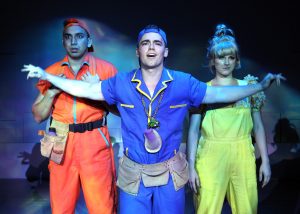‘Claudio Quest’ in Anaheim is a feel-good fairy tale for our fractured times
by Eric Marchese
 Do video game characters have internal lives of their own? They do in the minds of Marshall Pailet and Drew Fornarola, whose musical “Claudio Quest” shows us what really goes on inside a home video game.
Do video game characters have internal lives of their own? They do in the minds of Marshall Pailet and Drew Fornarola, whose musical “Claudio Quest” shows us what really goes on inside a home video game.
In the 2010 show’s West Coast premiere, Chance Theater delivers a production whose visual look and bouncy style mirror the bright colors, kinetic action, and constant motion and sound of the video games it both depicts and spoofs.
The specific games parodied are “Super Mario Bros.” of 1985 and the earlier “Donkey Kong” (1981), representing the earliest games played on 8-bit home computers of the late 1970s and early ’80s (Apple, Atari, Commodore, etc.).
Director Pailet’s staging has the wild look and style of a video game, and the show’s quirkily entertaining music, lyrics, script, story and characters fill Chance Theater’s stage with color, energy and fun.
The quiet opening scene depicts a little boy (Dylan Shube in the performance reviewed) playing the Claudio Quest video game on his older brother’s home computer. Soon, the entire universe of the game’s characters explodes onto the stage in the first musical number.
We meet game hero Claudio (Beau Brians), his dependable brother Luis (Andrew Puente), and Princess Poinsettia (Kim Dalton), whose repeated need to be rescued is the game’s object. Aiming to defeat Claudio and endanger the princess is bad guy Bruiser (Miguel Cardenas), a duck-billed platypus capable of exhaling deadly flames.
Just as Luis is overshadowed by his famous brother, the princess also has a younger sister, Princess Fish (Monika Pena), who’s treated by the Eggplant Kingdom’s denizens like an afterthought. As cheeky and ultra-bold as her sister is girly-girl, Fish’s kick-boxing skills repeatedly save the day.
Home computers like Commodores and Ataris that were at one time state of the art now represent technology that now seems jokily primitive – yet, Pailet and Fornarola have crafted more than a simple live-action parody, investing Claudio, Luis and Fish with desires, dreams and aspirations that are expressed in the show’s 18 songs.
The playful script brims with clever, offbeat touches, and not just for kids – most adults will enjoy seeing Claudio admit to Luis that he’s been using “moon juice” to enhance his abilities, a direct slam at professional athletes caught using PEDs.
Music director Ryan O’Connell has expertly orchestrated Pailet’s inventive score, which is part music, part computer-generated sounds. Sound effects include sonic tones à la ’80s video games – digital beeps and chirps and flourishes – and the songs, outlandish visual effects and choreographer Maxx Reed’s dance steps inject fun and energy into Chance’s production.
Vocally, Brians, Puente and Pena are first-rate pop-and-rock musical theater singers, well served in solos and by the part-melodic, part-lively Act Two song “Moon Power.”
Brians’ Claudio, a studly blue-clad hero, is engagingly confident and one-dimensional, turning deeper and more philosophical in Act Two. More than just an orange version of Claudio, Puente is utterly humble and likable as the modestly heroic Luis, while Pena’s plucky, fearless, charismatic Fish is a feisty bundle of energy who yearns to soar.
Cardenas uses a humorous lisp to soften Bruiser’s menace, and he enjoyably pulls off the villain’s sinisterly sexy semi-funk number “The Platypus Song.” As Elgafink, Bruiser’s sympathetic shrink, Kellie Spill gooses psychiatry and parodies psychobabble.
Dalton’s operatic soprano vocals as Poinsettia are unlike the show’s three leads – still played for laughs, but through a clearly different vocal style – and the four-woman, two-man ensemble energetically fills in all of the supporting and background roles depicting the colorful population of the “Claudio Quest” video universe.
Fred Kinney’s scenic design perfectly captures the look and horizontal-motion orientation of the earliest home video games, rimmed with vertical ladders and using tables of different heights to represent the game’s various horizontal “levels.”
Rachael Lorenzetti’s costumes feature a pleasing palette of basic colors – plenty of bright blues, oranges, greens and yellows – while black-clad baddie Bruiser is garbed like a member of a ’50s motorcycle gang. Justin Melillo’s animation, Matt Schleicher’s lighting and Ryan Brodkin’s sound add to the visual and audio effects meant to replicate a home video game.
Chance’s production of “Claudio Quest” is an imaginative, whimsical, lighthearted theatrical confection – a feel-good fairy-tale for our fractured times.
Leave a Reply
